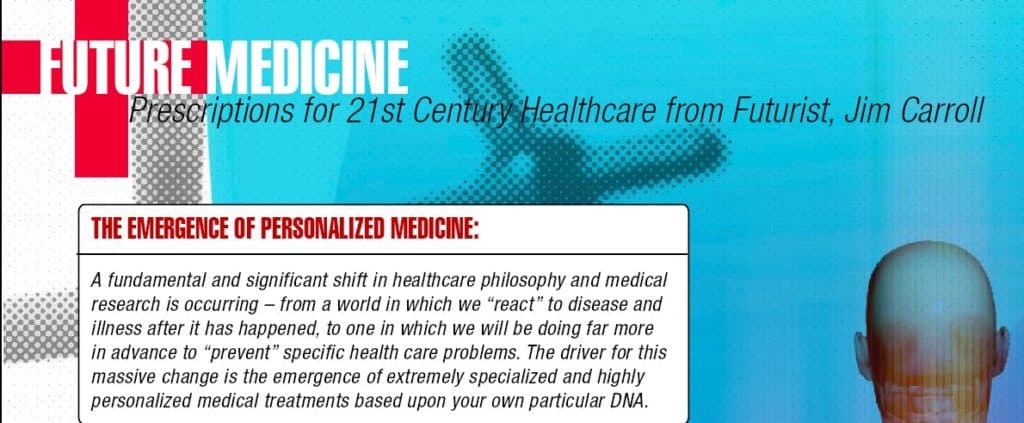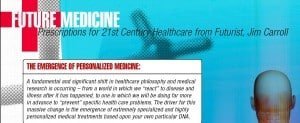I’ve spent a huge amount of time through the last many years, talking in countless industries about the trends that are at play and which will impact us in 2010 and beyond. I’ve been working these into the industry pages of my site, and will dump them on the blog as I do, since they provide a useful context for the many people searching for trends — and who stumble across my site.
So I put together this PDF – Future Medicine.

Here’s the big issues for healthcare:
- Knowledge growth becomes exponential — medical knowledge is now doubling every eight years. Expect it to be doubling every 2 years by 2010 — with the result that medical professionals will be struggling to an even greater degree in keeping up than they are today.
- Theory into practice becomes the primary focus. Because of the rapid discovery of new medical knowledge, you’ll get the most up to date treatment today only 50% of the time. Tomorrow, the prime focus in the medical community will be how to ingest and incorporate this new knowledge into practice.
- Skills fragment. Hyper-growth in knowledge and new medical discoveries means that every medical profession is becoming more specialized, leading to a an greater degree of niche-oriented medical skills than we see today.
- A battle for skills drives decisions. Skills fragmentation results in challenges, but so does the looming baby boomer retirement wave. 400,000 nurses are set to retire in the next 10 years. A war for medical talent drives much of the agenda of the industry by 2010, and the battleground is global in scope.
- Cost cutting becomes the focus. With the industry in a state of perpetual crisis due to skills shortages, new knowledge and unprecedented demand from aging baby boomers, health care institutions focus on trying to aggressively rip cost out of the system. Re-engineering of processes and methodology comes to a forefront within the system.
- Difficult philosophical questions rule administrative decisions. North American medical consumers now use up far more health care resources than they did 10 years ago, particularly because of the result of new discoveries, treatments and diagnostics. With ever-upward growth, the industry will start to challenge current assumptions, and medical professionals will demand an intelligent and reasonable debate on the difficult philosophical questions that surround the system.

- Bio-connectivity becomes the next big thing. A new generation of intelligent, Internet-connected medical devices flood the industry, providing new opportunities for monitoring and management of difficult health care conditions
- Hospitals get de-physical. Today, a health care institution is thought of as the building or campus that make up its constituent parts. Tomorrow, it will be defined by the reach of its virtual network, and the hospital will be thought of as the extended community network by which a good portion of its services are provided.
- Home health care and caregivers dominate the agenda. With the emergence of bio-connectivity and the de-physical hospital, home health care will come to dominate a huge part of the health care industry. There will be less focus on critical care health care beds, and more focus on opportunities to re-engineer the system through family and caregiver involvement in the home context, with bio-connectivity playing a big role.
- Generational attitude transforms the system. The entrance of Gen-Y — kids who are in 2005 aged 15 — into the health care system — will bring a flood of new ideas, innovation and new ways of thinking into the health care system, helping to break some of the organizational sclerosis that has clogged up the opportunity for change in the world of health care.
I’ve been doing quite a few keynotes and workshops in the healthcare industry, and I think there are a lot of folks who truly don’t appreciate the impact of these trends on the industry and upon professions.





GET IN TOUCH
Jim's Facebook page
You'll find Jim's latest videos on Youtube
Mastodon. What's on Jim's mind? Check his feed!
LinkedIn - reach out to Jim for a professional connection!
Flickr! Get inspired! A massive archive of all of Jim's daily inspirational quotes!
Instagram - the home for Jim's motivational mind!